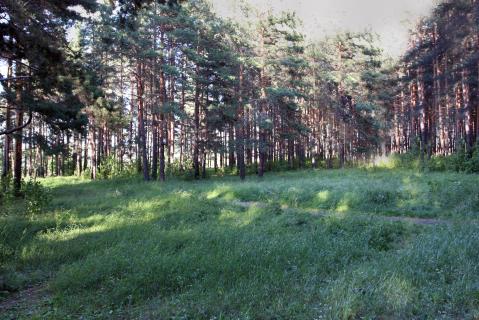The Bogoslovlag burial ground adjoins the town cemetery in Karpinsk. Prisoners and German forced labourers, mining coal at the Bogoslovsk open-cast mine were buried here in 1941-1944. Oral witnesses testify that the bodies were buried in wooden boxes; during summer they were buried in a deep trench, one on top of the other; in winter months, in a single layer. No signs were placed on the graves. The total number buried here is unknown; name lists are not available.
In the 1970s, the cemetery was destroyed, and the camp and civilian burials were replaced by the Komsomol Park. Dozens of graves of the old town cemetery have survived in the northwest corner of the park, as well as a section of the camp cemetery displaying the characteristic subsidence of mass graves.
In the early 1990s, the German Vozrozhdenie Society erected a monument on the section of camp burials. It bears a wreath of barbed wire and an inscription: “May we always remember those who died behind the barbed wire”. The plaque and the wreath disappeared in 2007.
The electronic Book of Remembrance (Gedenkbuch) of Russian Germans contains biographical entries on more than 100,000 Soviet Germans variously sentenced under Article 58, deported as forced settlers, or mobilised in camps of forced labourers.
The Memorial online database (2025) names 38,697 victims in the Sverdlovsk Region. See Yekaterinburg memorial.
Over 2,000 transient Germans (born and resident elsewhere) figured among these victims: more than 600 were shot, during the Great Terror and the war; most of the rest were sent to the camps.
Drawing on other sources, but especially the Krasnodar Krai police records, the database lists families and individuals (total 13,162) deported to the Sverdlovsk Region. 6,276 were “dekulakised” or born in special settlements. More than half of the 589, later deported by reason of their “nationality”, were Germans: families and individuals (total 233) were sent there directly in 1941 or 1942, or transferred via Novosibirsk Region or Kazakhstan.
| Date | Nature of ceremonies | Organiser or responsible person | Participants | Frequency |
|---|---|---|---|---|
|
nk
|
Commemorative Services
|
nk
|
nk
|
From time to time
|
| State of burials | Area | Boundaries |
|---|---|---|
|
subsidence indicates location of mass graves
|
area of camp burials, about 3,000 sq m
|
not delineated
|
[ Original texts & hyperlinks ]
Materials of an expedition to the Sverdlovsk Region (2008) – Memorial RIC Archive (St Petersburg)
N. Paegle, Behind the barbed wire in the Urals, Yekaterinburg, 2008

